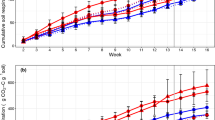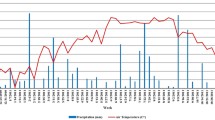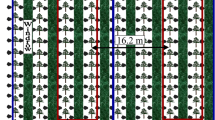Abstract
Aims
The Birch effect is a pulse in soil C and N mineralization caused by the wetting of dry soils, but the role of the soil moisture increment (ΔSWC) is still poorly understood. We quantified the relationship between ΔSWC and the Birch effect, and its interactions with pre-wetting soil moisture (preSWC) and substrate supply.
Methods
Two soils (clay loam and sandy loam) under a Pinus halepensis forest were subjected to rewetting in laboratory treatments combining different ΔSWC and preSWC values, with or without additional substrate (5 mg g-1 P. halepensis needles). Respiration flush (ΔR), changes in microbial biomass C (MBC) and net N mineralization (NMIN) were measured.
Results
Overall, we found a relationship with the form: ΔR = a ΔSWC + b, where the slope (a) was significant only when pre-wetting water potential was below a threshold value in the range of −100 to −1,200 kPa. However, the threshold alone does not fully describe the role of preSWC in slope variability. Substrate addition modified the ΔSWC sensitivity of Birch effect, enhancing it in the clay loam and suppressing it in the sandy loam.
Conclusions
The intensity of the wetting is a dominant factor regulating Birch effect, and ΔSWC is useful for its quantification.




Similar content being viewed by others
References
Austin AT, Yahdjian L, Stark JM, Belnap J, Porporato A, Norton U, Ravetta DA, Schaeffer SM (2004) Water pulses and biogeochemical cycles in arid and semiarid ecosystems. Oecologia 141:221–235
Berryman E, Marshall JD, Rahn T, Litvak M, Butnor J (2013) Decreased carbon limitation of litter respiration in a mortality-affected piñon-juniper woodland. Biogeosciences 10:1625–1634
Birch HF (1958) The effect of soil drying on humus decomposition and nitrogen. Plant soil 10:9–31
Borken W, Matzner E (2009) Reappraisal of drying and wetting effects on C and N mineralization and fluxes in soils. Global Change Biol 15:808–824
Bottner P (1985) Response of microbial biomass to alternate moist and dry conditions in a soil incubated with C-14-labeled and N-15-labeled plant material. Soil Biol Biochem 17:329–337
Butterly CR, Bünemann EK, McNeill AM, Baldock JA, Marschner P (2009) Carbon pulses but not phosphorus pulses are related to decreases in microbial biomass during repeated drying and rewetting of soils. Soil Biol Biochem 41:1406–1416
Cable JM, Ogle K, Williams DG, Weltzin JF, Huxman TE (2008) Soil texture drives responses of soil respiration to precipitation pulses in the Sonoran Desert: implications for climate change. Ecosystems 11:961–979
Campbell GS (1974) A simple method for determining unsaturated conductivity from moisture retention data. Soil Sci 117:311–314
Carbone MS, Still CJ, Ambrose AR, Dawson TE, Williams AP, Boot CM, Schaeffer SM, Schimel JP (2011) Seasonal and episodic moisture controls on plant and microbial contributions to soil respiration. Oecologia 167:265–278
Chatterjee A, Jenerette GD (2011) Changes in soil respiration Q10 during drying-rewetting along a semi-arid elevation gradient. Geoderma 163:171–177
Chowdhury N, Burns RG, Marschner P (2011a) Recovery of soil respiration after drying. Plant Soil 348:269–279
Chowdhury N, Nakatani AS, Setia R, Marschner P (2011b) Microbial activity and community composition in saline and non-saline soils exposed to multiple drying and rewetting events. Plant Soil 348:103–113
Cobos D, Campbell C (2007) Correcting temperature sensitivity of ECH2O soil moisture sensors. Application note. Decagon Devices Inc., Pullman
Daly E, Palmroth S, Stoy P, Siqueira M, Oishi AC, Juang JY, Oren R, Porporato A, Katul GG (2009) The effects of elevated atmospheric CO2 and nitrogen amendments on subsurface CO2 production and concentration dynamics in a maturing pine forest. Biogeochemistry 94:271–287
Denef K, Six J, Bossuyt H, Frey SD, Elliott ET, Merckx R, Paustian K (2001) Influence of dry-wet cycles on the interrelationship between aggregate, particulate organic matter, and microbial community dynamics. Soil Biol Biochem 33:1599–1611
Fernandez C, Lelong B, Vila B, Mévy JP, Robles C, Greff S, Dupouyet S, Bousquet-Mélou A (2006) Potential allelopathic effect of Pinus halepensis in the secondary succession: an experimental approach. Chemoecology 16:97–105
Fierer N, Schimel JP (2002) Effects of drying-rewetting frequency on soil carbon and nitrogen transformations. Soil Biol Biochem 34:777–787
Fischer T (2009) Substantial rewetting phenomena on soil respiration can be observed at low water availability. Soil Biol Biochem 41:1577–1579
Franzluebbers AJ, Haney RL, Honeycutt CW, Schomberg HH, Hons FM (2000) Flush of carbon dioxide following rewetting of dried soils relates to active organic pools. Soil Sci Soc Am J 64:613–623
García-Plé C, Vanrell P, Morey M (1995) Litter fall and decomposition in a Pinus halepensis forest on Mallorca. J Veg Sci 6:17–22
GVA (1995) Mapa de Suelos de la Comunidad Valenciana. Chelva (666). Proyecto LUCDEME (Icona), Centro de Investigaciones sobre Desertificación y Conselleria d’Agricultura i Mig Ambient. Generalitat Valenciana. Valencia, Spain. (Original in Spanish).
Halverson LJ, Jones TM, Firestone MK (2000) Release of intracellular solutes by four soil bacteria exposed to dilution stress. Soil Sci Soc Am J 64:1630–1637
Harrison-Kirk T, Beare MH, Meenken ED, Condron LM (2013) Soil organic matter and texture affect responses to dry/wet cycles: Effects on carbon dioxide and nitrous oxide emissions. Soil Biol Biochem 57:43–55
Harris RF (1981) Effect of water potential on microbial growth and activity. In: Parr JF, Gardner WR, Elliott LF (eds) Water potential relations in soil microbiology. Am Soc Agron, Madison, pp 23–95
Haynes RJ, Swift RS (1990) Stability of soil aggregates in relation to organic constituents and soil water content. J Soil Sci 41:73–83
Jarvis P, Rey A, Petsikos C, Wingate L, Rayment M, Pereira J, Banza J, David J, Miglietta F, Borghetti M, Manca G, Valentini R (2007) Drying and wetting of Mediterranean soils stimulates decomposition and carbon dioxide emission: the “Birch effect”. Tree Physiol 27:929–940
Kieft TL, Soroker E, Firestone MK (1987) Microbial biomass response to a rapid increase in water potential when dry soil is wetted. Soil Biol Biochem 19:119–126
Kim D, Mu S, Kang S, Lee D (2010) Factors controlling soil CO2 effluxes and the effects of rewetting on effluxes in adjacent deciduous, coniferous, and mixed forests in Korea. Soil Biol Biochem 42:576–585
Manzoni S, Schimel JP, Porporato A (2012) Responses of soil microbial communities to water stress: results from a meta-analysis. Ecology 93:930–938
McIntyre RES, Adams MA, Ford DJ, Grierson PF (2009) Rewetting and litter addition influence mineralisation and microbial communities in soils from a semi-arid intermittent stream. Soil Biol Biochem 41:92–101
Miller AE, Schimel JP, Meixner T, Sickman JO, Melack JM (2005) Episodic rewetting enhances carbon and nitrogen release from chaparral soils. Soil Biol Biochem 37:2195–2204
Muhr J, Franke J, Borken W (2010) Drying-rewetting events reduce C and N losses from a Norway spruce forest floor. Soil Biol Biochem 42:1303–1312
Navarro-García F, Casermeiro MA, Schimel JP (2012) When structure means conservation: Effect of aggregate structure in controlling microbial responses to rewetting events. Soil Biol Biochem 44:1–8
Rey A, Petsikos C, Jarvis PG, Grace J (2005) Effect of temperature and moisture on rates of carbon mineralization in a Mediterranean oak forest soil under controlled and field conditions. Eur J Soil Sci 56:589–599
Richards LA (1965) Physical condition of water in soil. In: Black CA, Evans DD, White JL, Ensminger LE, Clark FE (eds) Methods of soil analysis part 1. Agronomy series n°9. American Society of Agronomy, Madison
Scanlon BR, Andraski BJ, Bilskie J (2002) Miscellaneous methods for measuring matric or water potential. In: Dane JH, Topp GC (Eds) Methods of Soil Analysis. Part 4: Physical Methods. Soil Sci Soc Am, Madison. Wisconsin, pp: 643–670.
Schmitt A, Glaser B, Borken W, Martzner E (2010) Organic matter quality of a forest soil subjected to repeated drying and different re-wetting intensities. Eur J Soil Sci 61:243–254
Sponseller RA (2007) Precipitation pulses and soil CO2 flux in a Sonoran Desert ecosystem. Global Change Biol 13:426–436
Unger S, Máguas C, Pereira JS, David TS, Werner C (2010) The influence of precipitation pulses on soil respiration – Assessing the “Birch effect” by stable carbon isotopes. Soil Biol Biochem 42:1800–1810
Vance ED, Brookes PC, Jenkinson DS (1987) Microbial biomass measurements in forest soils: The use of the chloroform fumigation-incubation method in strongly acid soils. Soil Biol Biochem 19:697–702
Van Gestel M, Merckx R, Vlassak K (1993) Microbial biomass responses to soil drying and rewetting – the fate of fast-growing and slow-growing microorganisms in soils from different climates. Soil Biol Biochem 25:109–123
Wu J, Joergensen RG, Pommerening B, Chaussod R, Brookes PC (1990) Measurement of soil microbial biomass C by fumigation-extraction - an automated procedure. Soil Biol Biochem 22:1167–1169
Wu H, Lee X (2011) Short-term effects of rain on soil respiration in two New England forests. Plant Soil 338:329–342
Xiang SR, Doyle A, Holden PA, Schimel JP (2008) Drying and rewetting effects on C and N mineralization and microbial activity in surface and subsurface California grassland soils. Soil Biol Biochem 40:2281–2289
Xu LK, Baldocchi DD, Tang JW (2004) How soil moisture, rain pulses, and growth alter the response of ecosystem respiration to temperature. Global Biogeochem Cyc 18, GB4002. doi:10.1029/2004GB002281
Xu X, Luo X (2012) Effect of wetting intensity on soil GHG fluxes and microbial biomass under a temperate forest floor during dry season. Geoderma 170:118–126
Yuste JC, Janssens IA, Ceulemans R (2005) Calibration and validation of an empirical approach to model soil CO2 efflux in a deciduous forest. Biogeochemistry 73:209–230
Acknowledgments
This work was supported by a fellowship from Generalitat Valenciana, Consellería de Educación, Formación y Empleo awarded to L. Lado-Monserrat (BFPI/2008/041). Thanks are due to Antonio del Campo for help in data analyses and to Antonio Lloret for laboratory work. The authors wish to thank Joana Oliver for invaluable laboratory support. The authors also thank two anonymous reviewers and Professor Stephan Glatzel from the University of Rostock, Germany, for the critical review of the manuscript.
Author information
Authors and Affiliations
Corresponding author
Additional information
Responsible Editor: Klaus Butterbach-Bahl.
Electronic supplementary material
Below is the link to the electronic supplementary material.
Supplementary data Fig. 1
Respiration and moisture dynamics in Chelva soil for rewetting combinations with (a) preSWC=0.05 g g−1, (b) preSWC=0.10 g g−1, (c) preSWC=0.15 g g−1 and (d) preSWC=0.20 g g−1. Closed arrows indicate the first wetting and open arrows the second wetting. (JPEG 856 kb)
Supplementary data Fig. 2
Respiration and moisture dynamics in Tuéjar soil for rewetting combinations with (a) preSWC=0.05 g g−1, (b) preSWC=0.10 g g−1, (c) preSWC=0.15 g g−1 and (d) preSWC=0.20 and 0.25 g g−1. Closed arrows indicate the first wetting and open arrows the second wetting. (JPEG 901 kb)
Supplementary data Fig. 3
Relationship between respiration rate and soil moisture throughout the incubation experiment in Chelva unamended (a), Chelva amended (b), Tuéjar unamended (c) and Tuéjar amended (d) soils. (JPEG 468 kb)
Rights and permissions
About this article
Cite this article
Lado-Monserrat, L., Lull, C., Bautista, I. et al. Soil moisture increment as a controlling variable of the “Birch effect”. Interactions with the pre-wetting soil moisture and litter addition. Plant Soil 379, 21–34 (2014). https://doi.org/10.1007/s11104-014-2037-5
Received:
Accepted:
Published:
Issue Date:
DOI: https://doi.org/10.1007/s11104-014-2037-5




